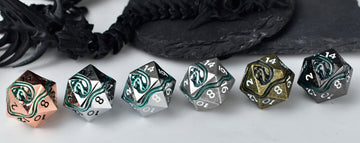Wenn es um die Beurteilung der Fairness von Würfeln geht, ist der Salzwassertest unter Hobbyisten die gängigste Methode. Diese Methode mag zwar bei leichten Plastikwürfeln einen groben Anhaltspunkt für die Balance liefern, funktioniert aber bei schweren Metallwürfeln wie den Serpent's Dagger Dice von Rule Dice nicht. Aufgrund ihrer Dichte und ihres Gewichts sinken Metallwürfel in der Regel unabhängig von einer inneren Unwucht, wodurch der Salzwassertest wirkungslos wird.
Deshalb haben wir einen anderen Ansatz gewählt. Um die Fairness unseres Serpent's Dagger W20 gründlich zu prüfen, haben wir ihn 1000 Mal gewürfelt – ja, tausend physische Würfe – und jedes Ergebnis aufgezeichnet. Das dauerte über eine Stunde. Der gesamte Vorgang wurde in einem Video dokumentiert, das Sie über den untenstehenden Link ansehen können . Das Ziel? Zu überprüfen, ob der Würfel auf allen 20 Seiten zufällig und gleichmäßig würfelt.
Seit wir zuletzt unser Testvideo und die Daten für den Serpent's Dagger Dice D20 veröffentlicht haben, haben wir zahlreiche Rückmeldungen erhalten. Einige von euch wünschten sich speziell einen Test des Serpent's Dagger D6-Würfels – und diesem Wunsch sind wir nachgekommen! Wir haben den D6 insgesamt 1.000 Mal gewürfelt und die Ergebnisse nun ebenfalls dem Datensatz hinzugefügt.
Analyse der Würfelergebnisse mit Bayes'scher Statistik
Zur Auswertung der Ergebnisse verwendeten wir ein leistungsstarkes statistisches Werkzeug namens Bayesian D&D Dice Analysis, das von evjrob entwickelt wurde . Diese Methode basiert auf Bayes'scher Inferenz und ermöglicht es uns, die Wahrscheinlichkeit der beobachteten Verteilung der Würfelergebnisse unter der Annahme zu bewerten, dass der Würfel fair ist (d. h., alle Seiten haben die gleiche Wahrscheinlichkeit zu erscheinen).
Die Bayes'sche Analyse prüft nicht nur, ob Ergebnisse von den Erwartungen abweichen, sondern quantifiziert auch die Unsicherheit und liefert eine A-posteriori-Verteilung. Diese gibt einen Wahrscheinlichkeitsbereich an, wie verzerrt oder fair ein Würfel sein könnte. In unserem Fall zeigte der Test, dass der Serpent's Dagger D20 & D6 als fair gelten kann .
D20:



D6:



Überprüfung mit John Ellmores Die Fairness Tester
Um die Ergebnisse weiter zu validieren, haben wir dieselben Würfeldaten in ein weiteres unabhängiges Tool eingegeben: John Ellmores Die Fairness Tester . Dieses Tool führt statistische Tests durch, darunter den Chi-Quadrat-Anpassungstest, um die Gleichmäßigkeit der Ergebnisverteilung zu bestimmen. Auch hier haben unsere Würfel D20 und D6 den Test bestanden – es zeigte sich keine signifikante Verzerrung .
D20:

D6:

Nachfolgend finden Sie eine statistische Grafik aus unserem Test mit 1.000 Würfen:


Wie die Grafik zeigt, liegt die Verteilung der Ergebnisse über alle 20 Seiten innerhalb der für einen fairen Würfel zu erwartenden Varianz.
Wenn Salzwasser versagt, rollen Sie für echtes
Schwimmtests in Salzwasser sind zwar eine schnelle Methode, aber bei Präzisionswürfeln, insbesondere aus Metall, ist ein echter Würfeltest der Goldstandard. Wenn Sie sich jemals über die Fairness eines Würfels unsicher sind, führen Sie einen umfangreichen Würfeltest durch und analysieren Sie die Daten mit zuverlässigen statistischen Werkzeugen wie evjrobs Bayesianischer Würfelanalyse oder John Ellmores Würfelfairness-Tester.
Endgültiges Urteil
Nach 1.000 aufeinanderfolgenden Würfen und zwei statistischen Tests können wir mit Stolz verkünden, dass der Serpent's Dagger D20 & D6 den Fairnesstest bestanden hat. Wenn auch Sie die Fairness Ihrer Würfel testen möchten, können Sie sich an unserer Testmethode orientieren. Auch wenn dies mehr Zeit in Anspruch nimmt, werden Sie mit dem Ergebnis zufrieden sein und die Daten sind zuverlässiger.
Verwendete Werkzeuge:
Sehen Sie sich das vollständige Testvideo von D20 an: https://www.youtube.com/watch?v=cdrE6H_5emM
Sehen Sie sich das vollständige Testvideo von D6 an: https://www.youtube.com/watch?v=95cGGeNYWPw

